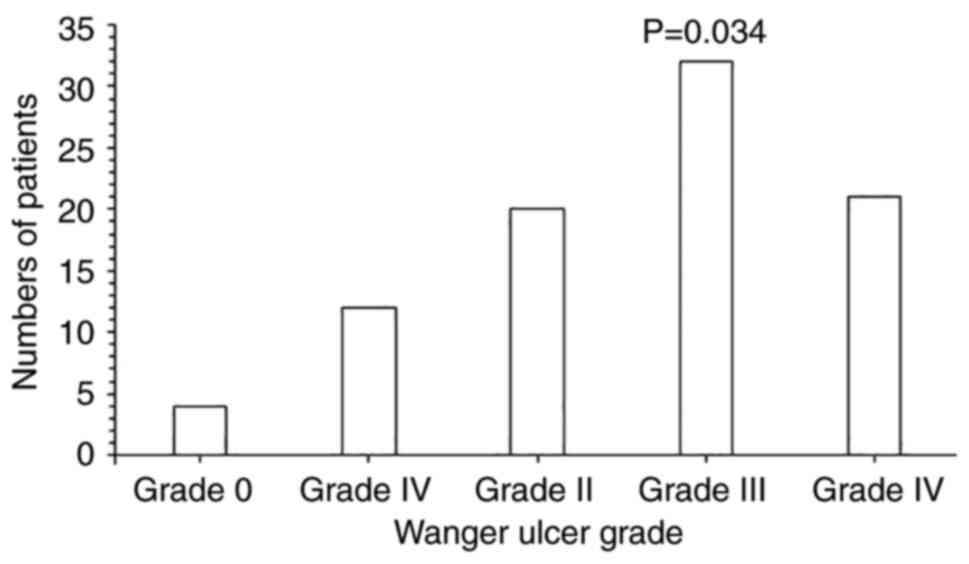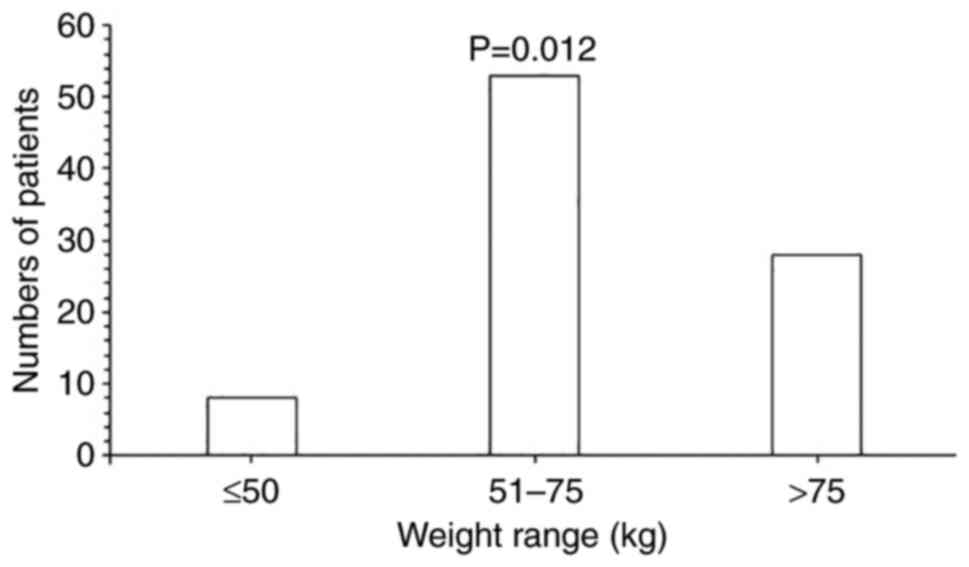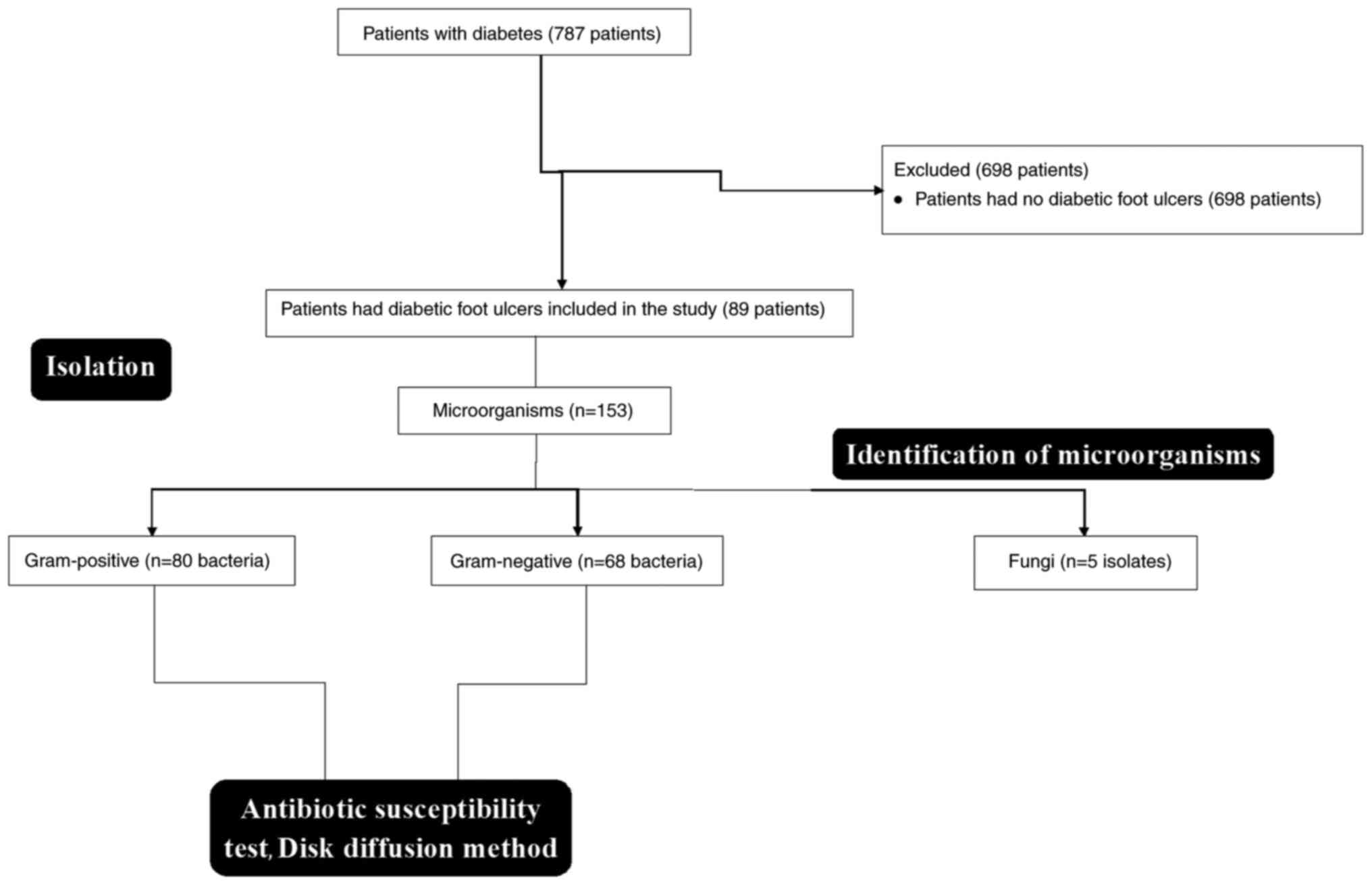|
1
|
Jiang Y, Ran X, Jia L, Yang C, Wang P, Ma
J, Chen B, Yu Y, Feng B, Chen L, et al: Epidemiology of type 2
diabetic foot problems and predictive factors for amputation in
China. Int J Low Extrem Wounds. 14:19–27. 2015.PubMed/NCBI View Article : Google Scholar
|
|
2
|
IDF Diabetes Atlas Group. Update of
mortality attributable to diabetes for the IDF diabetes atlas:
Estimates for the year 2013. Diabetes Res Clin Pract. 109:461–465.
2015.PubMed/NCBI View Article : Google Scholar
|
|
3
|
Sánchez-Sánchez M, Cruz-Pulido WL,
Bladinieres-Cámara E, Alcalá-Durán R, Rivera-Sánchez G and
Bocanegra-García V: Bacterial prevalence and antibiotic resistance
in clinical isolates of diabetic foot ulcers in the northeast of
Tamaulipas, Mexico. Int J Low Extrem Wounds. 16:129–134.
2017.PubMed/NCBI View Article : Google Scholar
|
|
4
|
Noor S, Zubair M and Ahmad J: Diabetic
foot ulcer-A review on pathophysiology, classification and
microbial etiology. Diabetes Metab Syndr. 9:192–199.
2015.PubMed/NCBI View Article : Google Scholar
|
|
5
|
Zhang P, Lu J, Jing Y, Tang S, Zhu D and
Bi Y: Global epidemiology of diabetic foot ulceration: A systematic
review and meta-analysis. Ann Med. 49:106–116. 2017.PubMed/NCBI View Article : Google Scholar
|
|
6
|
Markakis K, Bowling FL and Boulton AJ: The
diabetic foot in 2015: An overview. Diabetes Metab Res Rev. 32
(Suppl 1):S169–S178. 2016.PubMed/NCBI View Article : Google Scholar
|
|
7
|
van Battum P, Schaper N, Prompers L,
Apelqvist J, Jude E, Piaggesi A, Bakker K, Edmonds M, Holstein P,
Jirkovska A, et al: Differences in minor amputation rate in
diabetic foot disease throughout Europe are in part explained by
differences in disease severity at presentation. Diabet Med.
28:199–205. 2011.PubMed/NCBI View Article : Google Scholar
|
|
8
|
Xie X, Bao Y, Ni L, Liu D, Niu S, Lin H,
Li H, Duan C, Yan L, Huang S and Luo Z: Bacterial profile and
antibiotic resistance in patients with diabetic foot ulcer in
Guangzhou, southern China: Focus on the differences among different
Wagner's grades, IDSA/IWGDF grades, and ulcer types. Int J
Endocrinol. 2017(8694903)2017.PubMed/NCBI View Article : Google Scholar
|
|
9
|
Akhi MT, Ghotaslou R, Asgharzadeh M,
Varshochi M, Pirzadeh T, Memar MY, Zahedi Bialvaei A, Seifi Yarijan
Sofla H and Alizadeh N: Bacterial etiology and antibiotic
susceptibility pattern of diabetic foot infections in Tabriz, Iran.
GMS Hyg Infect Control. 10(Doc02)2015.PubMed/NCBI View Article : Google Scholar
|
|
10
|
Mendes JJ, Marques-Costa A, Vilela C,
Neves J, Candeias N, Cavaco-Silva P and Melo-Cristino J: Clinical
and bacteriological survey of diabetic foot infections in Lisbon.
Diabetes Res Clin Pract. 95:153–161. 2012.PubMed/NCBI View Article : Google Scholar
|
|
11
|
Al Wahbi A: Autoamputation of diabetic toe
with dry gangrene: A myth or a fact? Diabetes Metab Syndr Obes.
11:255–264. 2018.PubMed/NCBI View Article : Google Scholar
|
|
12
|
Ramakant P, Verma AK, Misra R, Prasad KN,
Chand G, Mishra A, Agarwal G, Agarwal A and Mishra SK: Changing
microbiological profile of pathogenic bacteria in diabetic foot
infections: Time for a rethink on which empirical therapy to
choose? Diabetologia. 54:58–64. 2011.PubMed/NCBI View Article : Google Scholar
|
|
13
|
Clinical and Laboratory Standards
Institute (CLSI). Performance Standards for Antimicrobial
Susceptibility Testing. 32nd edition. CSLI Supplement M100, Wayne,
PA, 2022.
|
|
14
|
Anvarinejad M, Pouladfar G, Japoni A,
Bolandparvaz S, Satiary Z, Abbasi P and Mardaneh J: Isolation and
antibiotic susceptibility of the microorganisms isolated from
diabetic foot infections in Nemazee hospital, Southern Iran. J
Pathog. 2015(328796)2015.PubMed/NCBI View Article : Google Scholar
|
|
15
|
Mendes JJ and Neves J: Diabetic foot
infections: Current diagnosis and treatment. J Diab Foot Compl.
4:26–45. 2012.
|
|
16
|
Gawey B and Czaja K: Broad-spectrum
antibiotic abuse and its connection to obesity. J Nutrition Health
Food Sci. 5:1–21. 2017.
|
|
17
|
Shah P, Inturi R, Anne D, Jadhav D,
Viswambharan V, Khadilkar R, Dnyanmote A and Shahi S: Wagner's
classification as a tool for treating diabetic foot ulcers: Our
observations at a suburban teaching hospital. Cureus.
14(e21501)2022.PubMed/NCBI View Article : Google Scholar
|
|
18
|
Thanganadar Appapalam S, Muniyan A,
Vasanthi Mohan K and Panchamoorthy R: A study on isolation,
characterization, and exploration of multiantibiotic-resistant
bacteria in the wound site of diabetic foot ulcer patients. Int J
Low Extrem Wounds. 20:6–14. 2021.PubMed/NCBI View Article : Google Scholar
|
|
19
|
Deribe B, Woldemichael K and Nemera G:
Prevalence and factors influencing diabetic foot ulcer among
diabetic patients attending arbaminch hospital, south Ethiopia. J
Diabetes Metab. 5:1–7. 2014.
|
|
20
|
Zubair M: Prevalence and
interrelationships of foot ulcer, risk-factors and antibiotic
resistance in foot ulcers in diabetic populations: A systematic
review and meta-analysis. World J Diabetes. 11:78–89.
2020.PubMed/NCBI View Article : Google Scholar
|
|
21
|
Richard JL, Sotto A and Lavigne JP: New
insights in diabetic foot infection. World J Diabetes. 2:24–32.
2011.PubMed/NCBI View Article : Google Scholar
|
|
22
|
Sekhar S, Vyas N, Unnikrishnan M,
Rodrigues G and Mukhopadhyay C: Antimicrobial susceptibility
pattern in diabetic foot ulcer: A pilot study. Ann Med Health Sci
Res. 4:742–745. 2014.PubMed/NCBI View Article : Google Scholar
|
|
23
|
Pontes DG, Silva ITDCE, Fernandes JJ,
Monteiro AFG, Gomes PHDS, Ferreira MGM, Lima FG, Correia JO, Santos
NJND and Cavalcante LP: Microbiologic characteristics and
antibiotic resistance rates of diabetic foot infections. Rev Col
Bras Cir. 47(e20202471)2020.PubMed/NCBI View Article : Google Scholar : (In English,
Portuguese).
|
|
24
|
Chaudhry WN, Badar R, Jamal M, Jeong J,
Zafar J and Andleeb S: Clinico-microbiological study and antibiotic
resistance profile of mecA and ESBL gene prevalence in patients
with diabetic foot infections. Exp Ther Med. 11:1031–1038.
2016.PubMed/NCBI View Article : Google Scholar
|
|
25
|
Agudelo Higuita NI and Huycke MM:
Enterococcal Disease, Epidemiology, and Implications for Treatment.
In: Enterococci: From Commensals to Leading Causes of Drug
Resistant Infection [Internet]. Gilmore MS, Clewell DB, Ike Y and
Shankar N (eds). Massachusetts Eye and Ear Infirmary, Boston, MA,
2014.
|
|
26
|
Sugandhi P and Prasanth DA:
Microbiological profile of bacterial pathogens from diabetic foot
infections in tertiary care hospitals, Salem. Diabetes Metab Syndr.
8:129–132. 2014.PubMed/NCBI View Article : Google Scholar
|
|
27
|
Dwedar R, Ismail DK and Abdulbaky A:
Diabetic foot infection: Microbiological causes with special
reference to their antibiotic resistance pattern. Egypt J Med
Microb. 24:95–102. 2015.PubMed/NCBI View Article : Google Scholar
|
|
28
|
Amini M, Davati A and Piri M:
Determination of the resistance pattern of prevalent aerobic
bacterial infections of diabetic foot ulcer. Iran J Pathol.
8:21–26. 2013.
|

















